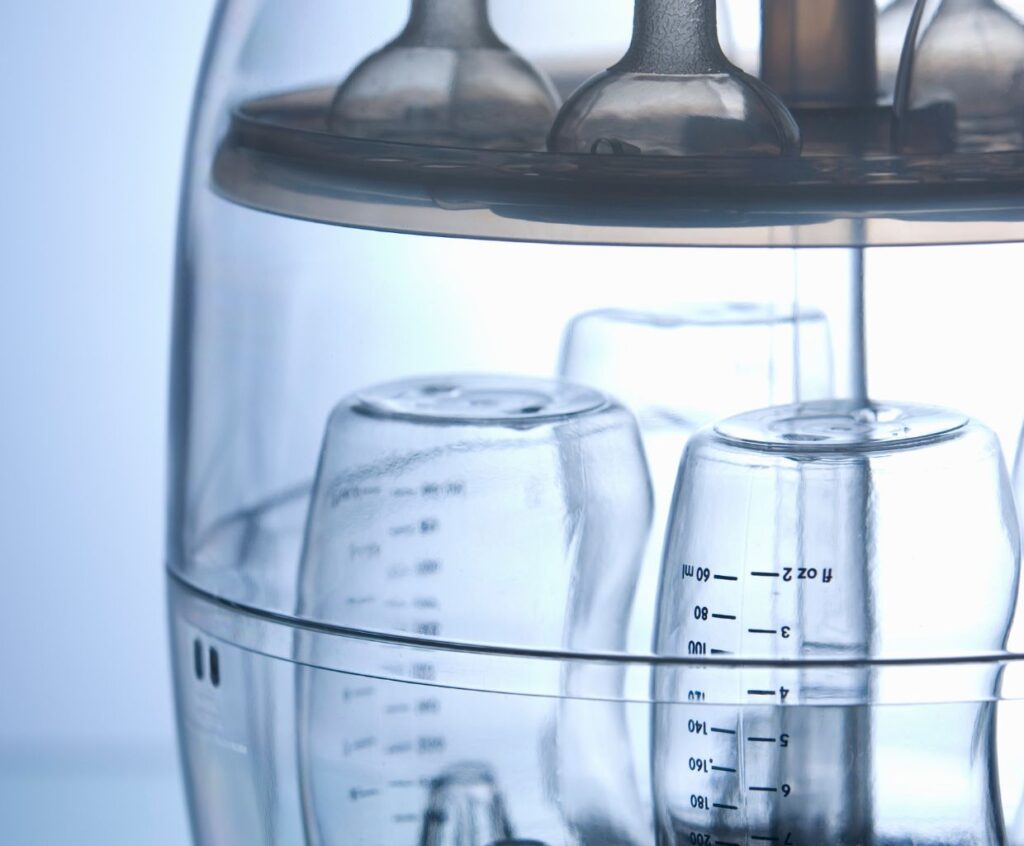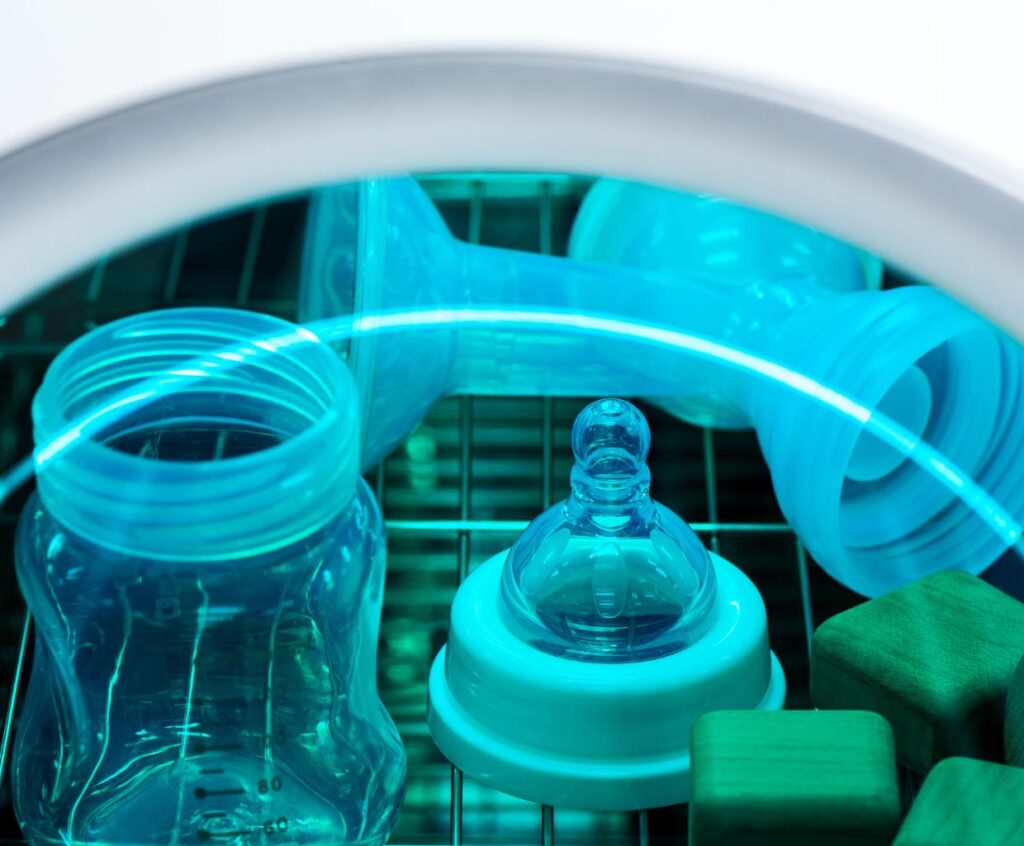How To Clean Baby Bottles Sterilizer?
Baby bottle sterilizers are essential for maintaining proper hygiene and ensuring the safety of your little one. They help eliminate harmful bacteria and germs from the bottles, nipples, and other accessories.
However, regular cleaning is necessary to ensure the sterilizer’s effectiveness and keep it in good condition.
Step-by-Step Guide to Clean Baby Bottles Sterilizer
Cleaning a baby bottle sterilizer is a simple process that requires a few basic steps. Here’s how you can do it:
-
- Unplug the Sterilizer: Before starting the cleaning process, make sure the sterilizer is unplugged and cooled down.
- Empty and Rinse: Remove any leftover water, bottles, or accessories from the sterilizer. Rinse them thoroughly under running water to remove any residue or buildup.
- Prepare a Cleaning Solution: Mix warm water and mild dish soap in a sink or basin. Avoid using harsh chemicals or abrasive cleaners as they may damage the sterilizer.
- Clean the Interior: Dip a soft sponge or cloth into the cleaning solution and gently wipe the interior of the sterilizer. Pay attention to any hard-to-reach areas or stains. Rinse the interior thoroughly with clean water.
- Clean the Exterior: Use a damp cloth or sponge to wipe the exterior of the sterilizer, removing any dirt or fingerprints. Dry it off with a clean towel.
- Descale (if necessary): If your sterilizer has mineral deposits or hard water buildup, you may need to descale it. Follow the manufacturer’s instructions or use a descaling solution for baby bottle sterilizers.
- Regular Maintenance: To keep your sterilizer in optimal condition, perform regular maintenance tasks such as descaling, inspecting the heating element, and replacing any worn-out parts as recommended by the manufacturer.
By following these simple steps, you can ensure that your baby bottle sterilizer remains clean, safe, and effective for your little one’s health. Always consult the manufacturer’s instructions for specific cleaning guidelines and recommendations for your sterilizer model.
What are some common mistakes to avoid when cleaning a baby bottle sterilizer to maintain effectiveness?
Cleaning a baby bottle sterilizer is essential to maintain its effectiveness and ensure your baby’s safety. Here are some common mistakes to avoid when cleaning a baby bottle sterilizer:
1. Not following the manufacturer’s instructions: Each baby bottle sterilizer may have specific cleaning instructions provided by the manufacturer. Make sure to read and follow these instructions carefully to avoid any mistakes.
2. Using harsh chemicals: Avoid using harsh chemicals, bleach, or abrasive cleaners to clean the sterilizer. These can damage the sterilizer and leave harmful residues that can be harmful to your baby. Stick to mild dish soap or baby bottle sterilizer cleaning solutions recommended by the manufacturer.
3. Neglecting regular cleaning: It’s essential to clean the sterilizer after each use to prevent the buildup of milk residue, formula, or other food particles that can lead to bacteria growth. Neglecting regular cleaning can compromise the sterilizer’s effectiveness.
4. Not descaling regularly: Mineral deposits can accumulate in the sterilizer over time, affecting its performance. Follow the manufacturer’s instructions for descaling the sterilizer at regular intervals to remove these deposits. This will ensure optimal functioning.
5. Not rinsing thoroughly: After cleaning or descaling the sterilizer, rinse it thoroughly to remove any soap or cleaning solution residue. Leaving any residue behind can be harmful to your baby.
6. Overloading the sterilizer: Avoid overcrowding the sterilizer with too many bottles or accessories. This can prevent proper steam circulation and compromise the sterilization process. Follow the manufacturer’s guidelines for the maximum number of items that can be sterilized at once.
7. Not drying properly: After cleaning, thoroughly dry all the parts of the sterilizer. Leaving them wet can promote the growth of bacteria or mold. Use a clean towel or air-dry the parts entirely before storing them.
By avoiding these common mistakes, you can ensure that your baby bottle sterilizer effectively kills harmful bacteria and provides a safe environment for your baby’s feeding equipment.
How often should a baby bottle sterilizer be cleaned to ensure proper hygiene?
After each use, a baby bottle sterilizer should be cleaned to ensure proper hygiene. This includes cleaning the sterilizing chamber, bottle racks, and any other parts that come into contact with the bottles. Regular cleaning will help prevent bacteria buildup and maintain the sterilizer’s effectiveness.
What are the recommended cleaning methods for a baby bottle sterilizer?
Cleaning a baby bottle sterilizer is essential to ensure it remains safe and effective. Here are some recommended cleaning methods for a baby bottle sterilizer:
1. Disassemble the sterilizer: Start by disassembling the sterilizer according to the manufacturer’s instructions. This usually involves removing removable parts, such as trays, racks, or heating elements.
2. Wash with warm, soapy water: Wash all the removable parts and the inside of the sterilizer with warm, soapy water. Use a mild dish soap and a soft sponge or brush to scrub away any residue or buildup gently. Be sure to clean all surfaces thoroughly.
3. Rinse thoroughly: Rinse all parts with clean water to remove any soap residue. Rinse all surfaces well to ensure no soap is left behind.
4. Use vinegar solution: To remove any mineral deposits or limescale, you can use a solution of equal parts water and white vinegar. Fill the sterilizer with this solution and let it sit for 15-20 minutes. Then, empty the solution and rinse thoroughly with clean water.
5. Wipe the exterior: Use a clean cloth or sponge dampened with warm, soapy water to wipe the exterior of the sterilizer. This will help remove any dirt or stains that may have accumulated.
6. Air dry: Allow all sterilizer parts to air dry entirely before reassembling or storing. This helps prevent the growth of bacteria or mold.
7. Regular maintenance: It is essential to regularly clean and descale your baby bottle sterilizer to maintain its effectiveness. Follow the manufacturer’s instructions for any specific maintenance or descaling procedures.
Always refer to the manufacturer’s instructions for your specific baby bottle sterilizer model, as cleaning methods may vary.


